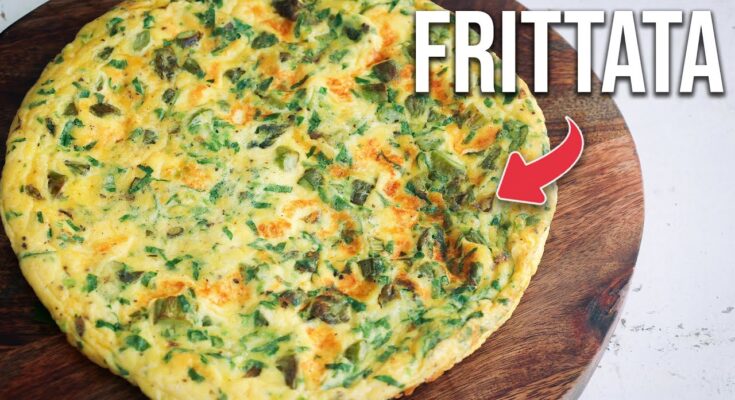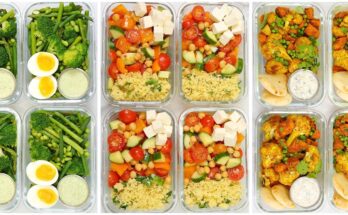Frittata Recipe: A frittata is one of those magical dishes that effortlessly blurs the line between breakfast and dinner. Think of it as the Italian cousin of the omelet—only heartier, more flavorful, and endlessly customizable. Unlike an omelet, where fillings are folded into the egg, a frittata mixes everything together and cooks it low and slow until golden and puffed.
Why are frittatas so beloved? They’re easy to make, incredibly versatile, and perfect for cleaning out your fridge. Got some leftover veggies or half a block of cheese? Throw it in. Leftover roasted chicken or sausage? Works great too. It’s the go-to dish for lazy weekend brunches, meal prep, or an elegant yet simple dinner.
Besides being quick to whip up, frittatas are a nutrition powerhouse. Packed with protein and veggies, they’re a great low-carb, gluten-free option that fits many diets. Whether you’re cooking for one or feeding a crowd, this dish delivers on all fronts—flavor, convenience, and satisfaction.
Ingredients for a Basic Frittata
Every frittata starts with a basic template, and from there, the possibilities are endless. Here’s what you’ll typically need:
Essential Ingredients
- Eggs: The star of the show. Use 6-8 eggs for a medium skillet (10-inch).
- Dairy: Milk or cream helps give the eggs a creamier texture. Use 1/4 to 1/2 cup.
- Salt & Pepper: Basic seasoning to enhance the natural egg flavor.
- Olive Oil or Butter: For greasing your pan and cooking your add-ins.
Optional Add-ins for Extra Flavor
- Cheese: Cheddar, feta, goat cheese, mozzarella, parmesan—anything you love.
- Vegetables: Bell peppers, spinach, mushrooms, zucchini, onions, tomatoes—the list is endless.
- Proteins: Bacon, sausage, ham, chicken, or even tofu for a vegetarian twist.
- Herbs & Spices: Basil, parsley, thyme, paprika, garlic powder, chili flakes.
You don’t need to use all of them. Just pick a protein, some veggies, and a cheese you like. The best part? You can eyeball most ingredients and still get great results.
Tools You’ll Need
Making a frittata doesn’t require any fancy kitchen gear, which makes it accessible to just about everyone.
Kitchen Tools Required
- Mixing Bowl: To beat your eggs and mix ingredients.
- Whisk or Fork: For blending eggs and dairy together.
- Cutting Board and Knife: To chop veggies and other add-ins.
- Spatula: To stir and transfer the mixture.
Recommended Pan Type
Your best friend here is an oven-safe, nonstick skillet, typically 8 to 10 inches in diameter. Cast iron pans are a favorite choice because they conduct heat evenly and create a beautiful golden crust. If you don’t have an oven-safe skillet, you can finish the frittata entirely on the stovetop, although you might not get that perfectly browned top.
Avoid pans that are too large or too deep, as they’ll thin out the frittata or cook it unevenly. You want the frittata to be thick enough to hold your fillings but not so thick that it won’t cook through.
Step-by-Step Instructions to Make a Frittata
Making a frittata is simple, but the magic lies in the order of operations. Follow these steps to get it just right:
Step 1: Prep Your Ingredients
Before you even turn on the stove, get everything ready. Chop your vegetables, grate your cheese, cook your proteins (like bacon or sausage), and measure out your dairy. Prepping ahead ensures a smoother cooking process and helps prevent overcooking anything.
Use paper towels to pat dry ingredients like spinach, tomatoes, or mushrooms. Excess moisture can make your frittata soggy, and no one wants that. Think of your prep as laying the foundation—you want dry, evenly chopped ingredients so that each bite is balanced and delicious.
This is also a good time to preheat your oven to 375°F (190°C) if you’re finishing the frittata in the oven.
Step 2: Sauté the Fillings
This step builds flavor. In your skillet, heat a tablespoon of olive oil or butter over medium heat. Add your harder vegetables like onions, peppers, and mushrooms first, cooking until they soften and caramelize. If you’re using leafy greens or softer veggies, add them last so they don’t wilt too much.
If you’re including cooked meats, toss them in just long enough to heat through. Season everything lightly with salt, pepper, or your favorite herbs. Once done, spread the mixture evenly across the pan and remove from heat while you prep the eggs.
Step 3: Beat the Eggs and Season
This step might seem basic, but how you beat your eggs can make or break the texture of your frittata. In a large bowl, crack in 6 to 8 eggs, depending on the size of your pan and how thick you want your frittata. Add your milk or cream—about 1/4 to 1/2 cup. This not only makes the frittata fluffier but adds richness too.
Whisk it all together thoroughly. You want the yolks and whites fully blended with no streaks. Whisking also incorporates air, which helps give the final dish a nice lift. Add a generous pinch of salt and a few cracks of black pepper. If you’re a spice lover, now’s the time to toss in some chili flakes or paprika.
You can also stir in chopped herbs like basil, parsley, or thyme to give your eggs a punch of freshness and color. Once your egg mixture is ready, set it aside—you’re almost there!
Step 4: Combine and Cook
Now, bring everything together. Place your skillet with the cooked veggies and/or proteins back on medium heat. Give it a few seconds to warm up, then pour the egg mixture evenly over the fillings in the pan. Use a spatula to gently move the edges of the egg inward as it starts to set, allowing uncooked egg to flow to the bottom. This helps the frittata cook more evenly and prevents overcooking the bottom.
At this stage, you can sprinkle your shredded or crumbled cheese over the top. Don’t stir it in—just let it melt into the egg mix as it cooks. Keep the heat at medium-low and let it cook for about 5 to 7 minutes, until the edges are set but the middle is still jiggly.
You’ll start to see the sides pulling away from the pan slightly, and the top will begin to puff. That’s your cue to either finish it on the stovetop (with a lid) or transfer it to the oven.
Step 5: Finish in the Oven or on the Stove
For that beautifully browned top and a perfect set, finishing in the oven is the best move. If your skillet is oven-safe, place it on the middle rack of your preheated oven (375°F or 190°C) and bake for 8 to 12 minutes. Keep an eye on it—once the center is firm and the top is lightly golden, it’s done.
No oven? No problem. Just cover your skillet with a lid and let it finish cooking on low heat. This method works just fine, though you may not get that classic golden crust on top.
Once cooked, remove the skillet from heat and let the frittata rest for about 5 minutes. This helps the flavors settle and makes slicing easier. Then slice into wedges and serve warm—or even cold. Frittata’s versatility is one of its biggest charms.
Pro Tips for the Perfect Frittata
Let’s face it, eggs are simple—but frittatas can be tricky without a few insider tricks. These tips will help you get that just-right texture and flavor every time.
- Don’t overcook. The number one frittata sin is rubbery eggs. Always remove it from heat just as the center sets. It will continue to cook slightly from residual heat.
- Use full-fat dairy. If you’re adding milk or cream, use whole milk or half-and-half. Low-fat options tend to water down your mixture and mess with the texture.
- Balance your fillings. Don’t overload with fillings. Keep the ratio to about 1 to 1.5 cups of add-ins per 6–8 eggs.
- Keep it dry. Wet vegetables are the enemy. Cook off moisture in mushrooms, spinach, or tomatoes before adding eggs.
- Preheat the oven. If finishing in the oven, make sure it’s properly preheated to avoid sudden temperature drops, which can affect cooking time and texture.
- Let it rest. Allowing your frittata to cool slightly helps it firm up, making slicing cleaner and neater.
Whether you’re going for a light brunch or hearty dinner, mastering these tips will elevate your frittata game every time.
Common Frittata Variations
The base of a frittata is just a blank canvas. You can dress it up however you like. Here are some delicious variations to inspire your next creation:
Veggie Frittata
Perfect for a light, nutritious meal. Use sautéed mushrooms, spinach, bell peppers, zucchini, or tomatoes. Pair with goat cheese or feta for a tangy bite. Finish with fresh herbs for brightness.
Meat Lover’s Frittata
For something heartier, add crumbled bacon, cooked sausage, diced ham, or shredded chicken. Sharp cheddar or smoked gouda works well with meaty fillings. Add onions or roasted peppers for contrast.
Cheese Lover’s Frittata
Go heavy on the cheese! Combine mozzarella for meltiness, parmesan for sharpness, and brie or goat cheese for creaminess. This variation is rich, indulgent, and perfect for cheese fans.
Each variation follows the same basic method—just swap in your chosen ingredients while keeping the total volume balanced.
Serving Suggestions
So, your frittata is golden, puffy, and smells amazing—what do you serve it with? While it’s delicious on its own, pairing it with the right sides can turn it into a complete, memorable meal.
Best Sides to Serve With
- Fresh Greens: A crisp arugula or spinach salad with lemon vinaigrette balances out the richness of the eggs and cheese.
- Crusty Bread: A slice of sourdough or toasted baguette is perfect for scooping up bites of frittata.
- Fruit Salad: Fresh berries, melon, or citrus can brighten up the plate and refresh your palate.
- Roasted Potatoes: Whether they’re seasoned wedges or simple hash browns, potatoes are a hearty companion.
A brunch spread might also include avocado toast, mimosas, or yogurt parfaits for that extra wow factor.
Ideal Times to Enjoy Frittata
Frittatas aren’t just for breakfast—they shine at any meal. Here are a few perfect occasions:
- Brunch with friends: Elegant, easy to prepare, and feeds a crowd.
- Meal prep: Frittata slices store well and reheat easily—great for grab-and-go breakfasts or lunches.
- Light dinner: Serve with a salad and a glass of wine for a classy, simple dinner.
- Picnics or potlucks: Frittatas travel well and taste great at room temperature.
No matter when or where, this dish fits right in. That’s the beauty of it—it’s adaptable and always satisfying.
Storing and Reheating Frittata
Got leftovers? Lucky you. Frittatas store wonderfully, and a few smart steps will help you keep them fresh and tasty.
Storage Tips
- Refrigeration: Let the frittata cool completely. Then, store slices in an airtight container or wrap them individually in foil or plastic wrap. They’ll last up to 4 days in the fridge.
- Freezing: For longer storage, wrap slices tightly and freeze for up to 2 months. Use parchment paper between layers to prevent sticking.
Reheating Without Drying Out
- Microwave: Place a slice on a plate, cover with a damp paper towel, and heat in 30-second intervals until warm.
- Oven: Reheat at 350°F (175°C) for 10–15 minutes for a slightly crisp edge and more even heat.
- Skillet: Heat gently on the stovetop with a lid over low heat. Add a splash of water to the pan to create steam and prevent drying out.
Avoid overcooking during reheating—it can make the eggs rubbery. Gentle heat is key.
Troubleshooting Your Frittata
Even with the simplest recipes, things can go sideways. Here’s how to fix (or avoid) common frittata fails:
Common Mistakes and How to Fix Them
- Rubbery texture? That means it was overcooked. Next time, pull it from heat when it’s just set. Residual heat finishes the job.
- Watery bottom? Likely from too many watery vegetables or uncooked spinach. Sauté and drain these before adding them in.
- Stuck to the pan? Use enough oil or a nonstick skillet. If it’s still sticking, run a spatula around the edge before flipping or slicing.
- Underseasoned? Eggs need more salt than you think. Don’t be shy—taste your fillings before mixing with eggs.
Learning to read the signs of doneness and prepping ingredients properly will take your frittatas from “okay” to “amazing” with very little extra effort.
FAQs about Frittata Recipe
1. What ingredients do I need to make a frittata?
A basic frittata requires eggs, salt, and pepper. You can enhance it with a variety of additions like cheese, vegetables (such as spinach, peppers, and onions), and proteins (like ham or sausage). Feel free to experiment with whatever ingredients you have in your fridge!
2. How many eggs do I need for a frittata?
A standard frittata recipe calls for about 6 to 8 eggs. This serves around 4 to 6 people. Adjust the number of eggs based on the size of your pan and the number of servings needed.
3. Can I make a frittata in the oven?
Yes, frittatas can be started on the stove and finished in the oven. Preheat your oven to 350°F (175°C), start cooking the frittata on the stove to set the bottom, then transfer it to the oven to cook the top evenly.
4. How do I know when the frittata is done?
A frittata is done when the eggs are set and the top is slightly golden. This usually takes about 15-20 minutes in the oven after starting it on the stove. You can also insert a knife in the center to check if it comes out clean.
5. Can I make a frittata ahead of time?
Absolutely! Frittatas are perfect for making ahead. Cook it fully, let it cool, then refrigerate. Reheat in the oven or on the stove when ready to serve. It’s a great option for meal prep or quick breakfasts throughout the week.
6. Are there any tips for making the perfect frittata?
For the best frittata, evenly distribute your fillings in the egg mixture before cooking. Avoid overcooking to keep the eggs tender, and consider adding a splash of milk or cream to the eggs for a fluffier texture. Season well to bring out the flavors of your add-ins.
Conclusion
There you have it—your complete, no-fuss guide to making the perfect frittata. It’s one of those dishes that’s hard to mess up but easy to perfect with a few tricks. Whether you’re whipping one up for Sunday brunch, using it for meal prep, or just making a quick weeknight dinner, a frittata delivers in flavor, texture, and flexibility.
The best part? You don’t need to follow a strict recipe. Once you get the base method down, the sky’s the limit. Use what you have, make it your own, and enjoy every bite.
References
For those eager to delve deeper into the art of crafting the perfect frittata and exploring various ingredient combinations, the following reputable sources provide a wealth of information. These resources are ideal for both beginners and seasoned cooks looking to enhance their culinary skills.
- Epicurious – Offers a comprehensive guide on frittata essentials, including tips on choosing the right skillet and creative ingredient variations. Read more about frittata basics on Epicurious.
- Serious Eats – Known for its scientific approach to cooking, Serious Eats provides in-depth articles on the techniques that ensure a fluffy and moist frittata, plus a range of recipes showcasing global flavors. Explore frittata techniques at Serious Eats.
- Food Network – A go-to source for recipe ideas from celebrity chefs. Here you can find step-by-step videos and recipes for making the perfect frittata, suitable for any meal of the day. Check out Food Network’s frittata recipes.
- AllRecipes – Features user-submitted recipes and reviews, giving readers a variety of frittata recipes tested by home cooks worldwide. This site is particularly useful for seeing how different ingredients and methods pan out in home kitchens. Visit AllRecipes for frittata recipes.
- The Kitchn – Provides practical advice on everything from basic frittata recipes to more innovative dishes. It’s an excellent resource for those looking to experiment with new ingredients. Learn more at The Kitchn.
Each of these sources offers unique insights and practical tips that can help elevate your frittata-making skills, ensuring delicious results every time. Whether you’re a novice or an experienced chef, these references will guide you through the process of creating a versatile and satisfying dish.



